Racial Differences in Attitudes Toward the Chicago Police Department Research Question 2022
VerifiedAdded on 2022/08/10
|15
|3979
|11
AI Summary
Contribute Materials
Your contribution can guide someone’s learning journey. Share your
documents today.
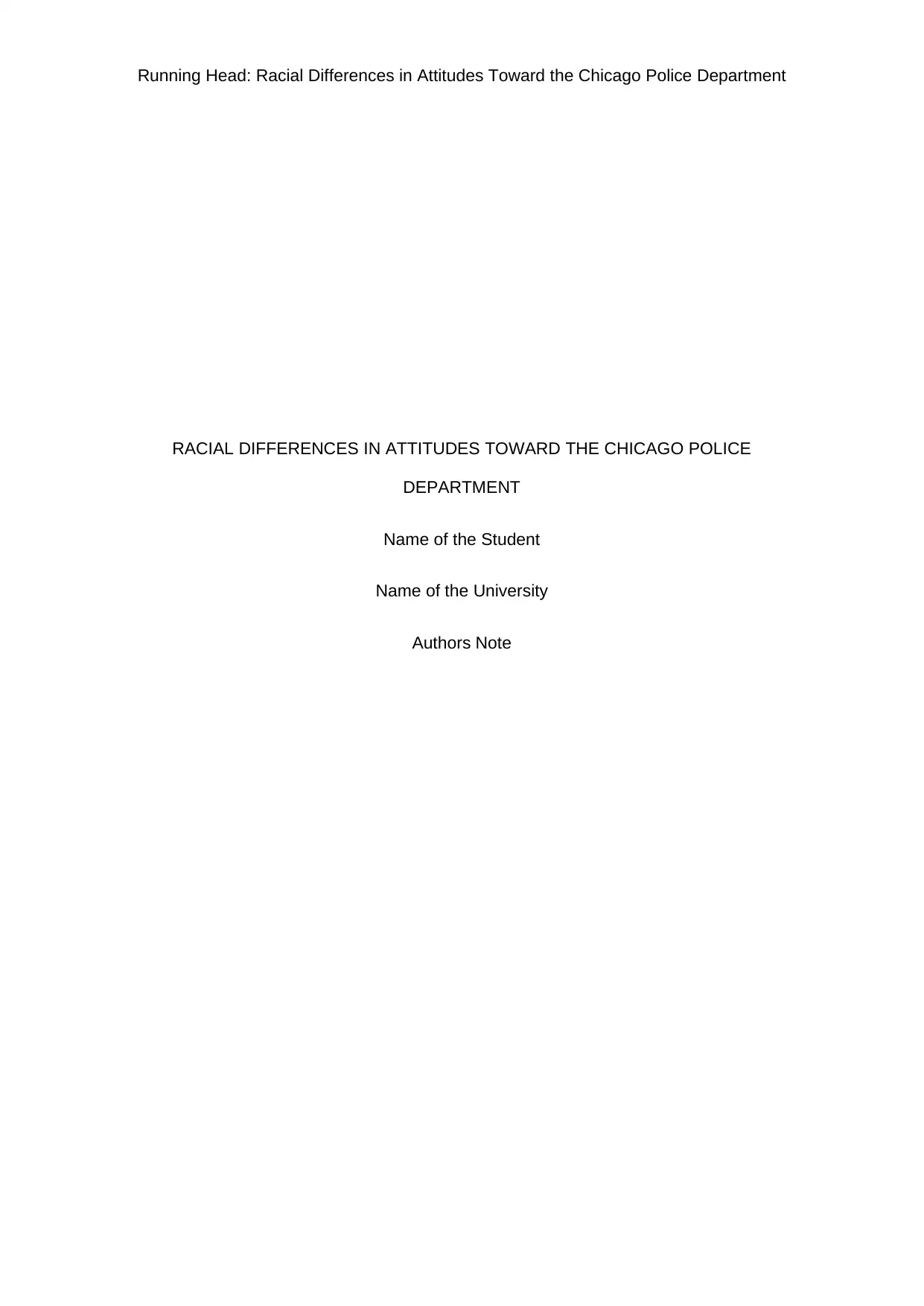
Running Head: Racial Differences in Attitudes Toward the Chicago Police Department
RACIAL DIFFERENCES IN ATTITUDES TOWARD THE CHICAGO POLICE
DEPARTMENT
Name of the Student
Name of the University
Authors Note
RACIAL DIFFERENCES IN ATTITUDES TOWARD THE CHICAGO POLICE
DEPARTMENT
Name of the Student
Name of the University
Authors Note
Secure Best Marks with AI Grader
Need help grading? Try our AI Grader for instant feedback on your assignments.
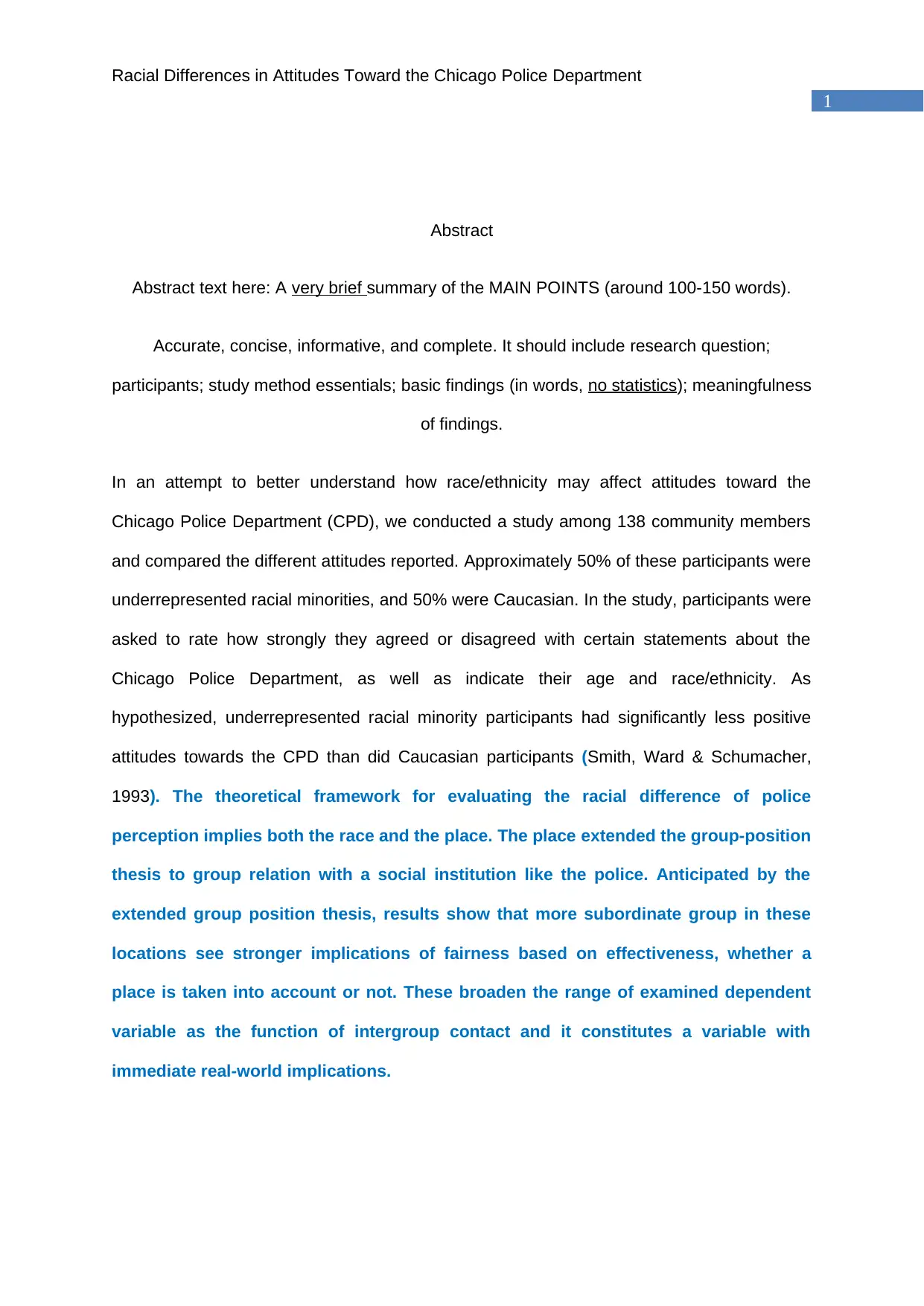
1
Racial Differences in Attitudes Toward the Chicago Police Department
Abstract
Abstract text here: A very brief summary of the MAIN POINTS (around 100-150 words).
Accurate, concise, informative, and complete. It should include research question;
participants; study method essentials; basic findings (in words, no statistics); meaningfulness
of findings.
In an attempt to better understand how race/ethnicity may affect attitudes toward the
Chicago Police Department (CPD), we conducted a study among 138 community members
and compared the different attitudes reported. Approximately 50% of these participants were
underrepresented racial minorities, and 50% were Caucasian. In the study, participants were
asked to rate how strongly they agreed or disagreed with certain statements about the
Chicago Police Department, as well as indicate their age and race/ethnicity. As
hypothesized, underrepresented racial minority participants had significantly less positive
attitudes towards the CPD than did Caucasian participants (Smith, Ward & Schumacher,
1993). The theoretical framework for evaluating the racial difference of police
perception implies both the race and the place. The place extended the group-position
thesis to group relation with a social institution like the police. Anticipated by the
extended group position thesis, results show that more subordinate group in these
locations see stronger implications of fairness based on effectiveness, whether a
place is taken into account or not. These broaden the range of examined dependent
variable as the function of intergroup contact and it constitutes a variable with
immediate real-world implications.
Racial Differences in Attitudes Toward the Chicago Police Department
Abstract
Abstract text here: A very brief summary of the MAIN POINTS (around 100-150 words).
Accurate, concise, informative, and complete. It should include research question;
participants; study method essentials; basic findings (in words, no statistics); meaningfulness
of findings.
In an attempt to better understand how race/ethnicity may affect attitudes toward the
Chicago Police Department (CPD), we conducted a study among 138 community members
and compared the different attitudes reported. Approximately 50% of these participants were
underrepresented racial minorities, and 50% were Caucasian. In the study, participants were
asked to rate how strongly they agreed or disagreed with certain statements about the
Chicago Police Department, as well as indicate their age and race/ethnicity. As
hypothesized, underrepresented racial minority participants had significantly less positive
attitudes towards the CPD than did Caucasian participants (Smith, Ward & Schumacher,
1993). The theoretical framework for evaluating the racial difference of police
perception implies both the race and the place. The place extended the group-position
thesis to group relation with a social institution like the police. Anticipated by the
extended group position thesis, results show that more subordinate group in these
locations see stronger implications of fairness based on effectiveness, whether a
place is taken into account or not. These broaden the range of examined dependent
variable as the function of intergroup contact and it constitutes a variable with
immediate real-world implications.
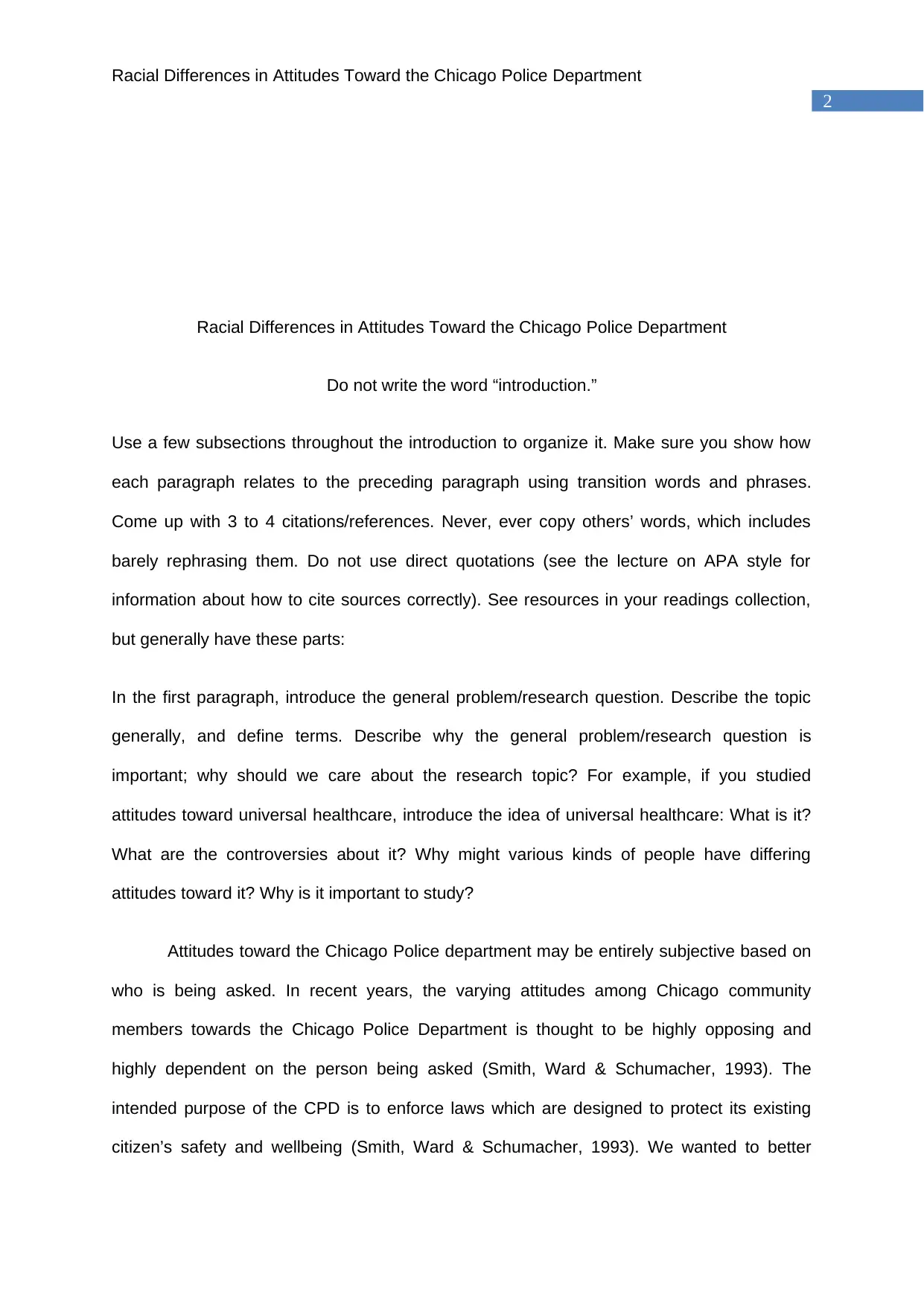
2
Racial Differences in Attitudes Toward the Chicago Police Department
Racial Differences in Attitudes Toward the Chicago Police Department
Do not write the word “introduction.”
Use a few subsections throughout the introduction to organize it. Make sure you show how
each paragraph relates to the preceding paragraph using transition words and phrases.
Come up with 3 to 4 citations/references. Never, ever copy others’ words, which includes
barely rephrasing them. Do not use direct quotations (see the lecture on APA style for
information about how to cite sources correctly). See resources in your readings collection,
but generally have these parts:
In the first paragraph, introduce the general problem/research question. Describe the topic
generally, and define terms. Describe why the general problem/research question is
important; why should we care about the research topic? For example, if you studied
attitudes toward universal healthcare, introduce the idea of universal healthcare: What is it?
What are the controversies about it? Why might various kinds of people have differing
attitudes toward it? Why is it important to study?
Attitudes toward the Chicago Police department may be entirely subjective based on
who is being asked. In recent years, the varying attitudes among Chicago community
members towards the Chicago Police Department is thought to be highly opposing and
highly dependent on the person being asked (Smith, Ward & Schumacher, 1993). The
intended purpose of the CPD is to enforce laws which are designed to protect its existing
citizen’s safety and wellbeing (Smith, Ward & Schumacher, 1993). We wanted to better
Racial Differences in Attitudes Toward the Chicago Police Department
Racial Differences in Attitudes Toward the Chicago Police Department
Do not write the word “introduction.”
Use a few subsections throughout the introduction to organize it. Make sure you show how
each paragraph relates to the preceding paragraph using transition words and phrases.
Come up with 3 to 4 citations/references. Never, ever copy others’ words, which includes
barely rephrasing them. Do not use direct quotations (see the lecture on APA style for
information about how to cite sources correctly). See resources in your readings collection,
but generally have these parts:
In the first paragraph, introduce the general problem/research question. Describe the topic
generally, and define terms. Describe why the general problem/research question is
important; why should we care about the research topic? For example, if you studied
attitudes toward universal healthcare, introduce the idea of universal healthcare: What is it?
What are the controversies about it? Why might various kinds of people have differing
attitudes toward it? Why is it important to study?
Attitudes toward the Chicago Police department may be entirely subjective based on
who is being asked. In recent years, the varying attitudes among Chicago community
members towards the Chicago Police Department is thought to be highly opposing and
highly dependent on the person being asked (Smith, Ward & Schumacher, 1993). The
intended purpose of the CPD is to enforce laws which are designed to protect its existing
citizen’s safety and wellbeing (Smith, Ward & Schumacher, 1993). We wanted to better
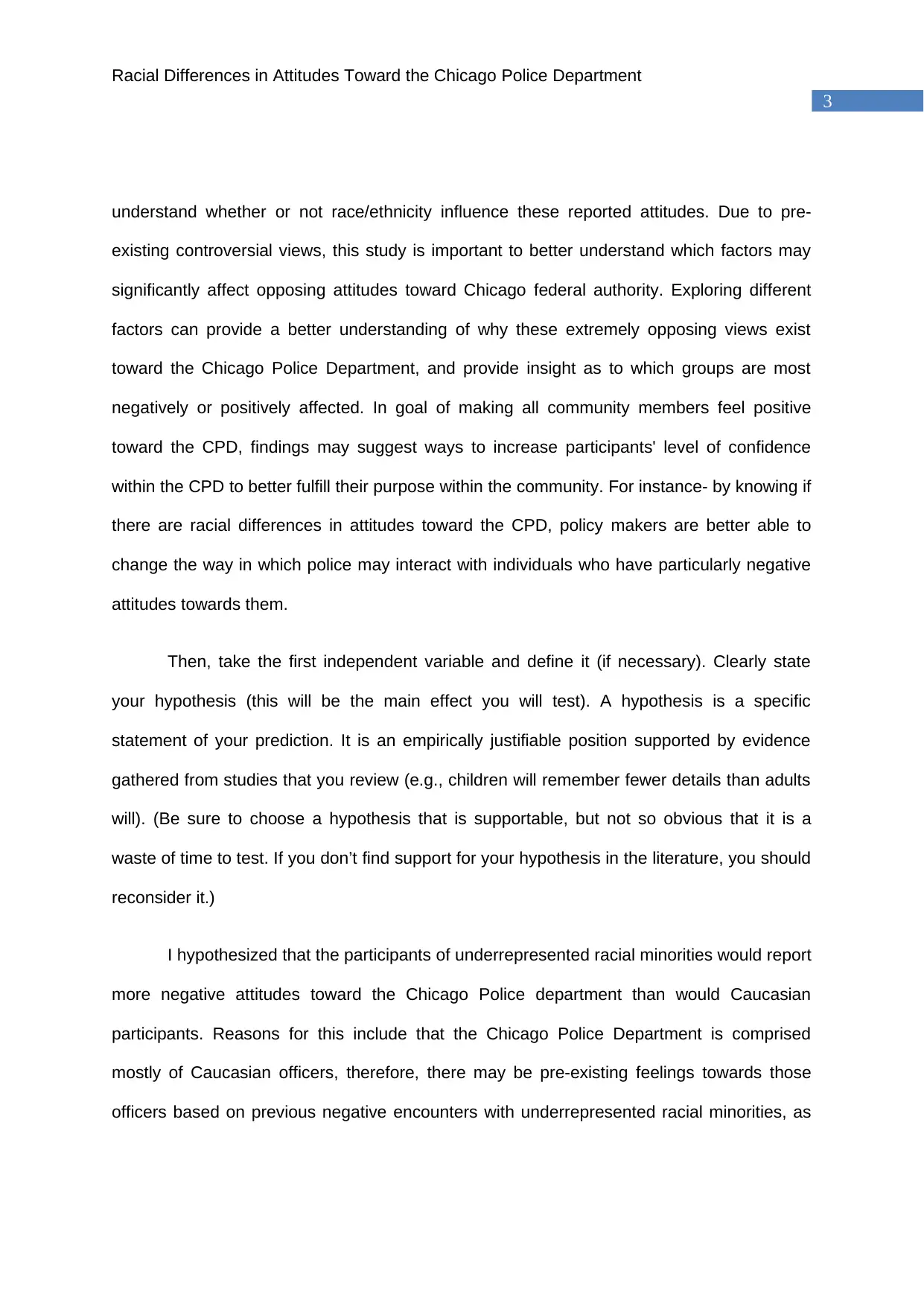
3
Racial Differences in Attitudes Toward the Chicago Police Department
understand whether or not race/ethnicity influence these reported attitudes. Due to pre-
existing controversial views, this study is important to better understand which factors may
significantly affect opposing attitudes toward Chicago federal authority. Exploring different
factors can provide a better understanding of why these extremely opposing views exist
toward the Chicago Police Department, and provide insight as to which groups are most
negatively or positively affected. In goal of making all community members feel positive
toward the CPD, findings may suggest ways to increase participants' level of confidence
within the CPD to better fulfill their purpose within the community. For instance- by knowing if
there are racial differences in attitudes toward the CPD, policy makers are better able to
change the way in which police may interact with individuals who have particularly negative
attitudes towards them.
Then, take the first independent variable and define it (if necessary). Clearly state
your hypothesis (this will be the main effect you will test). A hypothesis is a specific
statement of your prediction. It is an empirically justifiable position supported by evidence
gathered from studies that you review (e.g., children will remember fewer details than adults
will). (Be sure to choose a hypothesis that is supportable, but not so obvious that it is a
waste of time to test. If you don’t find support for your hypothesis in the literature, you should
reconsider it.)
I hypothesized that the participants of underrepresented racial minorities would report
more negative attitudes toward the Chicago Police department than would Caucasian
participants. Reasons for this include that the Chicago Police Department is comprised
mostly of Caucasian officers, therefore, there may be pre-existing feelings towards those
officers based on previous negative encounters with underrepresented racial minorities, as
Racial Differences in Attitudes Toward the Chicago Police Department
understand whether or not race/ethnicity influence these reported attitudes. Due to pre-
existing controversial views, this study is important to better understand which factors may
significantly affect opposing attitudes toward Chicago federal authority. Exploring different
factors can provide a better understanding of why these extremely opposing views exist
toward the Chicago Police Department, and provide insight as to which groups are most
negatively or positively affected. In goal of making all community members feel positive
toward the CPD, findings may suggest ways to increase participants' level of confidence
within the CPD to better fulfill their purpose within the community. For instance- by knowing if
there are racial differences in attitudes toward the CPD, policy makers are better able to
change the way in which police may interact with individuals who have particularly negative
attitudes towards them.
Then, take the first independent variable and define it (if necessary). Clearly state
your hypothesis (this will be the main effect you will test). A hypothesis is a specific
statement of your prediction. It is an empirically justifiable position supported by evidence
gathered from studies that you review (e.g., children will remember fewer details than adults
will). (Be sure to choose a hypothesis that is supportable, but not so obvious that it is a
waste of time to test. If you don’t find support for your hypothesis in the literature, you should
reconsider it.)
I hypothesized that the participants of underrepresented racial minorities would report
more negative attitudes toward the Chicago Police department than would Caucasian
participants. Reasons for this include that the Chicago Police Department is comprised
mostly of Caucasian officers, therefore, there may be pre-existing feelings towards those
officers based on previous negative encounters with underrepresented racial minorities, as
Secure Best Marks with AI Grader
Need help grading? Try our AI Grader for instant feedback on your assignments.
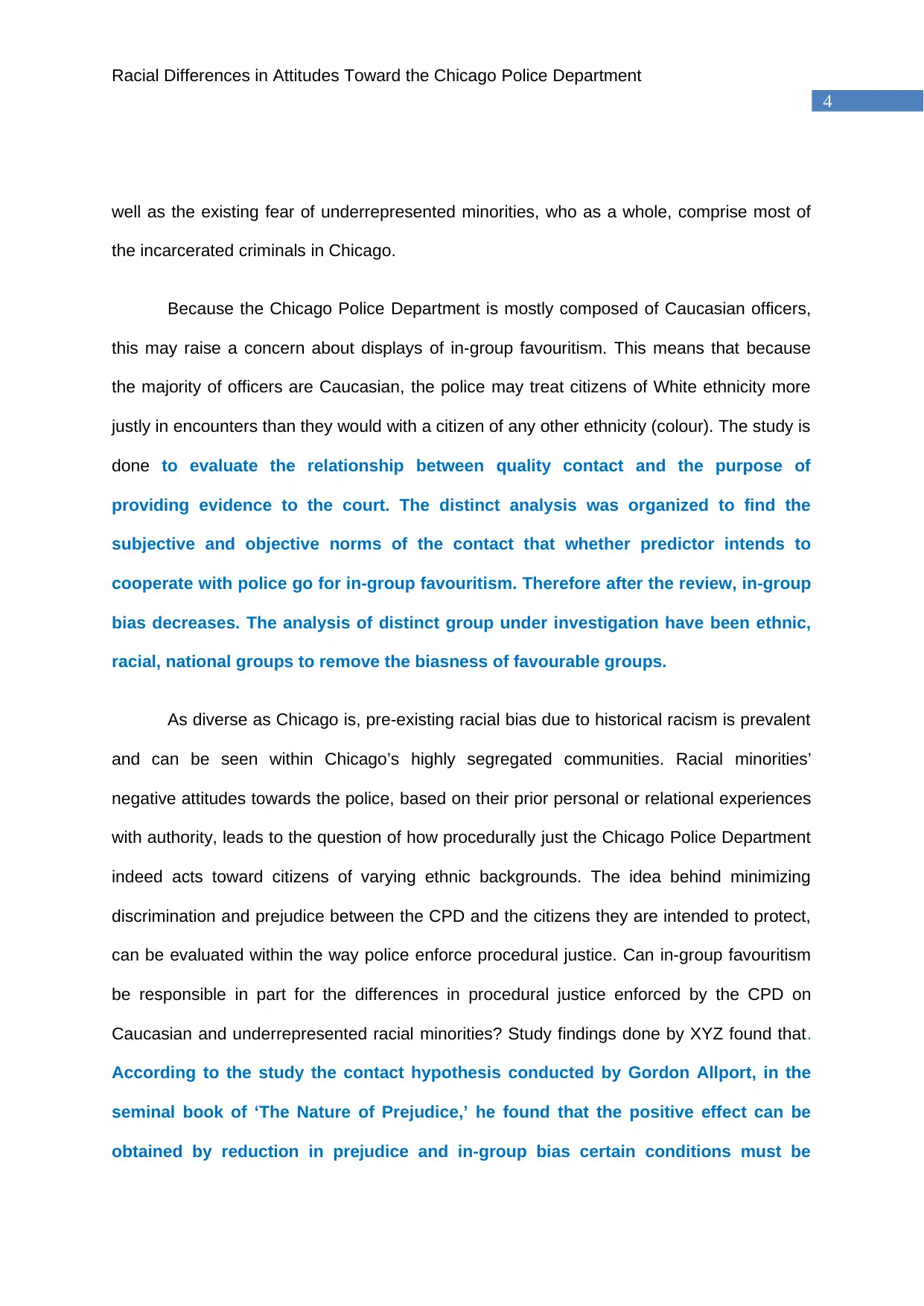
4
Racial Differences in Attitudes Toward the Chicago Police Department
well as the existing fear of underrepresented minorities, who as a whole, comprise most of
the incarcerated criminals in Chicago.
Because the Chicago Police Department is mostly composed of Caucasian officers,
this may raise a concern about displays of in-group favouritism. This means that because
the majority of officers are Caucasian, the police may treat citizens of White ethnicity more
justly in encounters than they would with a citizen of any other ethnicity (colour). The study is
done to evaluate the relationship between quality contact and the purpose of
providing evidence to the court. The distinct analysis was organized to find the
subjective and objective norms of the contact that whether predictor intends to
cooperate with police go for in-group favouritism. Therefore after the review, in-group
bias decreases. The analysis of distinct group under investigation have been ethnic,
racial, national groups to remove the biasness of favourable groups.
As diverse as Chicago is, pre-existing racial bias due to historical racism is prevalent
and can be seen within Chicago’s highly segregated communities. Racial minorities’
negative attitudes towards the police, based on their prior personal or relational experiences
with authority, leads to the question of how procedurally just the Chicago Police Department
indeed acts toward citizens of varying ethnic backgrounds. The idea behind minimizing
discrimination and prejudice between the CPD and the citizens they are intended to protect,
can be evaluated within the way police enforce procedural justice. Can in-group favouritism
be responsible in part for the differences in procedural justice enforced by the CPD on
Caucasian and underrepresented racial minorities? Study findings done by XYZ found that.
According to the study the contact hypothesis conducted by Gordon Allport, in the
seminal book of ‘The Nature of Prejudice,’ he found that the positive effect can be
obtained by reduction in prejudice and in-group bias certain conditions must be
Racial Differences in Attitudes Toward the Chicago Police Department
well as the existing fear of underrepresented minorities, who as a whole, comprise most of
the incarcerated criminals in Chicago.
Because the Chicago Police Department is mostly composed of Caucasian officers,
this may raise a concern about displays of in-group favouritism. This means that because
the majority of officers are Caucasian, the police may treat citizens of White ethnicity more
justly in encounters than they would with a citizen of any other ethnicity (colour). The study is
done to evaluate the relationship between quality contact and the purpose of
providing evidence to the court. The distinct analysis was organized to find the
subjective and objective norms of the contact that whether predictor intends to
cooperate with police go for in-group favouritism. Therefore after the review, in-group
bias decreases. The analysis of distinct group under investigation have been ethnic,
racial, national groups to remove the biasness of favourable groups.
As diverse as Chicago is, pre-existing racial bias due to historical racism is prevalent
and can be seen within Chicago’s highly segregated communities. Racial minorities’
negative attitudes towards the police, based on their prior personal or relational experiences
with authority, leads to the question of how procedurally just the Chicago Police Department
indeed acts toward citizens of varying ethnic backgrounds. The idea behind minimizing
discrimination and prejudice between the CPD and the citizens they are intended to protect,
can be evaluated within the way police enforce procedural justice. Can in-group favouritism
be responsible in part for the differences in procedural justice enforced by the CPD on
Caucasian and underrepresented racial minorities? Study findings done by XYZ found that.
According to the study the contact hypothesis conducted by Gordon Allport, in the
seminal book of ‘The Nature of Prejudice,’ he found that the positive effect can be
obtained by reduction in prejudice and in-group bias certain conditions must be
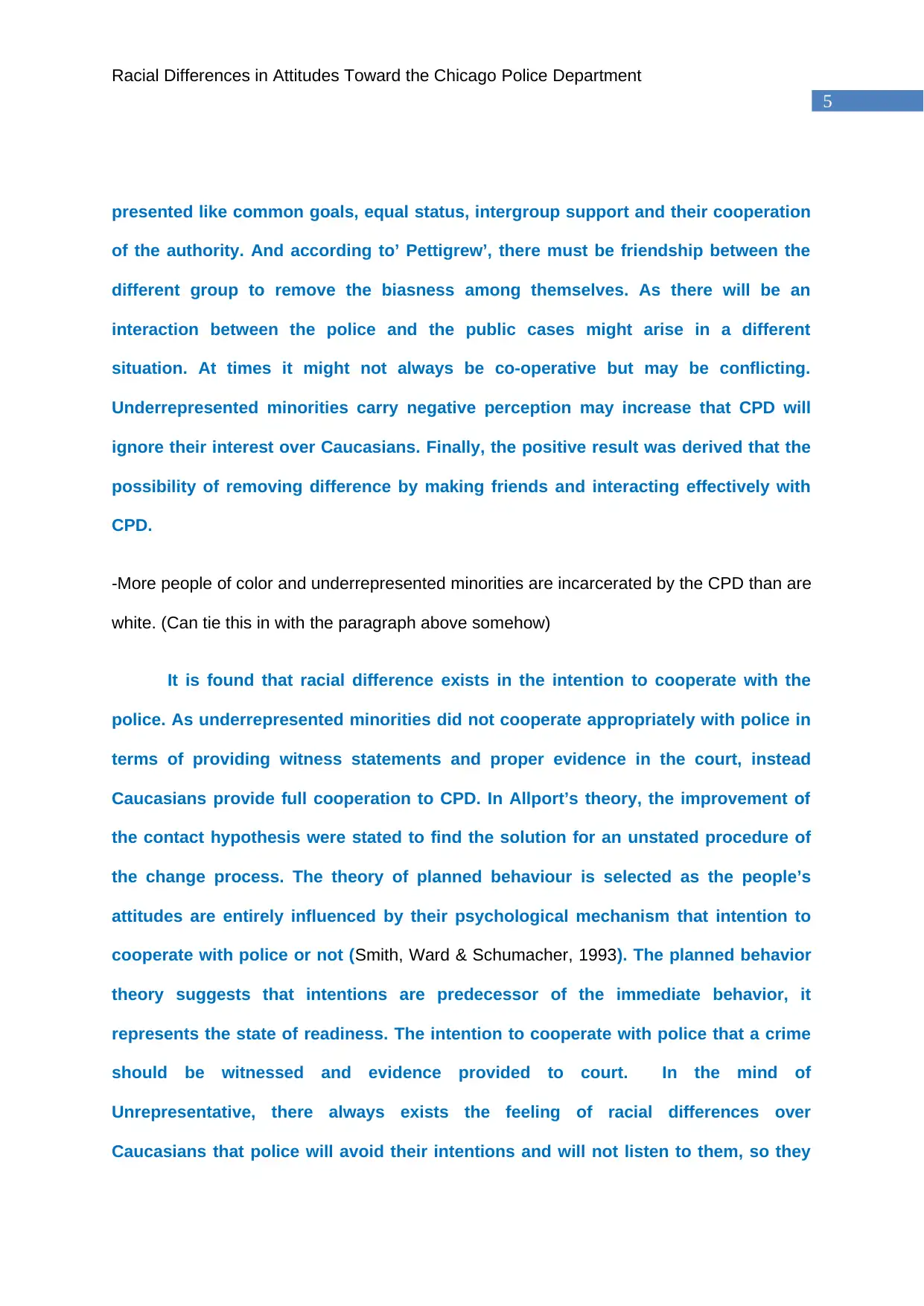
5
Racial Differences in Attitudes Toward the Chicago Police Department
presented like common goals, equal status, intergroup support and their cooperation
of the authority. And according to’ Pettigrew’, there must be friendship between the
different group to remove the biasness among themselves. As there will be an
interaction between the police and the public cases might arise in a different
situation. At times it might not always be co-operative but may be conflicting.
Underrepresented minorities carry negative perception may increase that CPD will
ignore their interest over Caucasians. Finally, the positive result was derived that the
possibility of removing difference by making friends and interacting effectively with
CPD.
-More people of color and underrepresented minorities are incarcerated by the CPD than are
white. (Can tie this in with the paragraph above somehow)
It is found that racial difference exists in the intention to cooperate with the
police. As underrepresented minorities did not cooperate appropriately with police in
terms of providing witness statements and proper evidence in the court, instead
Caucasians provide full cooperation to CPD. In Allport’s theory, the improvement of
the contact hypothesis were stated to find the solution for an unstated procedure of
the change process. The theory of planned behaviour is selected as the people’s
attitudes are entirely influenced by their psychological mechanism that intention to
cooperate with police or not (Smith, Ward & Schumacher, 1993). The planned behavior
theory suggests that intentions are predecessor of the immediate behavior, it
represents the state of readiness. The intention to cooperate with police that a crime
should be witnessed and evidence provided to court. In the mind of
Unrepresentative, there always exists the feeling of racial differences over
Caucasians that police will avoid their intentions and will not listen to them, so they
Racial Differences in Attitudes Toward the Chicago Police Department
presented like common goals, equal status, intergroup support and their cooperation
of the authority. And according to’ Pettigrew’, there must be friendship between the
different group to remove the biasness among themselves. As there will be an
interaction between the police and the public cases might arise in a different
situation. At times it might not always be co-operative but may be conflicting.
Underrepresented minorities carry negative perception may increase that CPD will
ignore their interest over Caucasians. Finally, the positive result was derived that the
possibility of removing difference by making friends and interacting effectively with
CPD.
-More people of color and underrepresented minorities are incarcerated by the CPD than are
white. (Can tie this in with the paragraph above somehow)
It is found that racial difference exists in the intention to cooperate with the
police. As underrepresented minorities did not cooperate appropriately with police in
terms of providing witness statements and proper evidence in the court, instead
Caucasians provide full cooperation to CPD. In Allport’s theory, the improvement of
the contact hypothesis were stated to find the solution for an unstated procedure of
the change process. The theory of planned behaviour is selected as the people’s
attitudes are entirely influenced by their psychological mechanism that intention to
cooperate with police or not (Smith, Ward & Schumacher, 1993). The planned behavior
theory suggests that intentions are predecessor of the immediate behavior, it
represents the state of readiness. The intention to cooperate with police that a crime
should be witnessed and evidence provided to court. In the mind of
Unrepresentative, there always exists the feeling of racial differences over
Caucasians that police will avoid their intentions and will not listen to them, so they
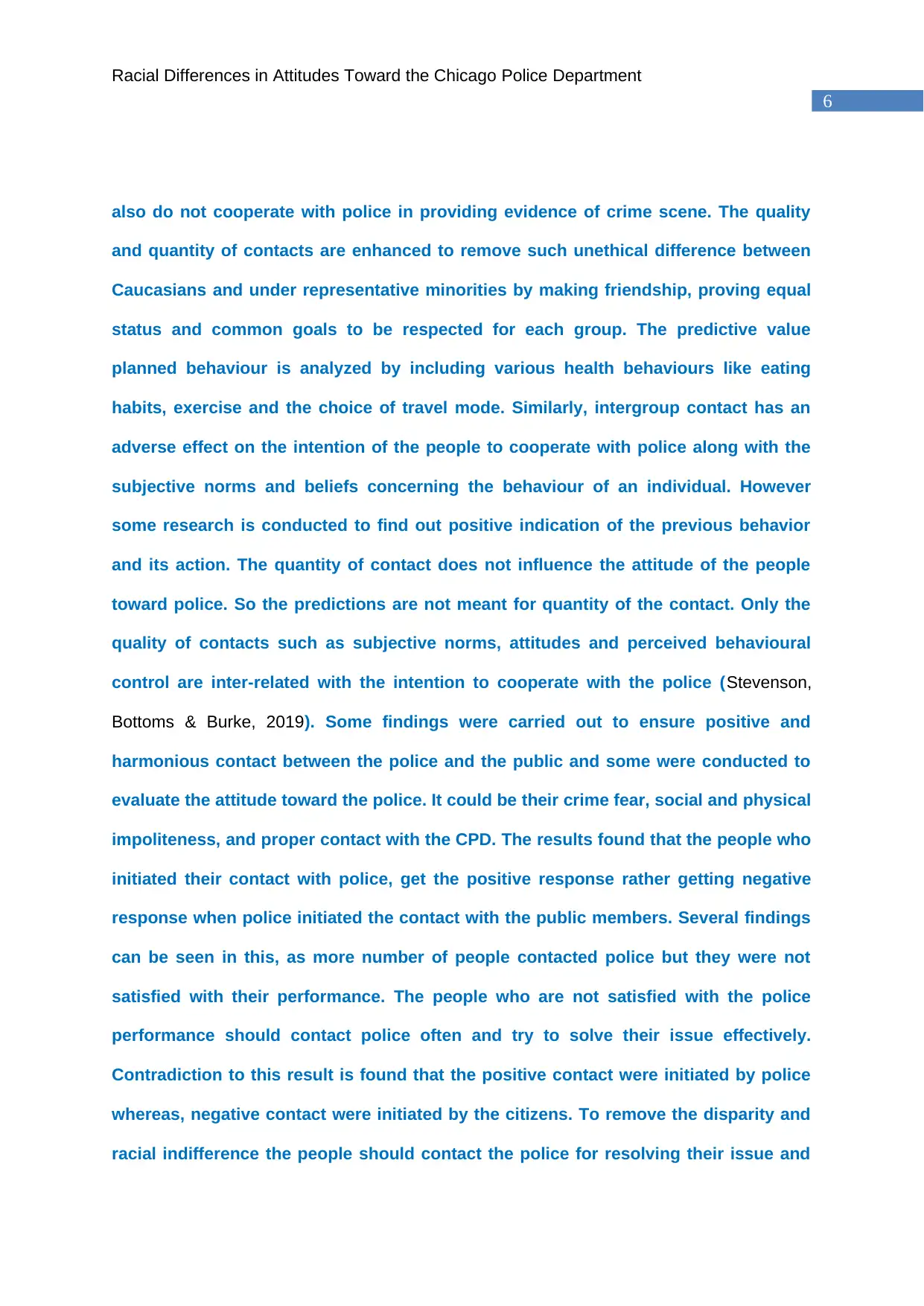
6
Racial Differences in Attitudes Toward the Chicago Police Department
also do not cooperate with police in providing evidence of crime scene. The quality
and quantity of contacts are enhanced to remove such unethical difference between
Caucasians and under representative minorities by making friendship, proving equal
status and common goals to be respected for each group. The predictive value
planned behaviour is analyzed by including various health behaviours like eating
habits, exercise and the choice of travel mode. Similarly, intergroup contact has an
adverse effect on the intention of the people to cooperate with police along with the
subjective norms and beliefs concerning the behaviour of an individual. However
some research is conducted to find out positive indication of the previous behavior
and its action. The quantity of contact does not influence the attitude of the people
toward police. So the predictions are not meant for quantity of the contact. Only the
quality of contacts such as subjective norms, attitudes and perceived behavioural
control are inter-related with the intention to cooperate with the police (Stevenson,
Bottoms & Burke, 2019). Some findings were carried out to ensure positive and
harmonious contact between the police and the public and some were conducted to
evaluate the attitude toward the police. It could be their crime fear, social and physical
impoliteness, and proper contact with the CPD. The results found that the people who
initiated their contact with police, get the positive response rather getting negative
response when police initiated the contact with the public members. Several findings
can be seen in this, as more number of people contacted police but they were not
satisfied with their performance. The people who are not satisfied with the police
performance should contact police often and try to solve their issue effectively.
Contradiction to this result is found that the positive contact were initiated by police
whereas, negative contact were initiated by the citizens. To remove the disparity and
racial indifference the people should contact the police for resolving their issue and
Racial Differences in Attitudes Toward the Chicago Police Department
also do not cooperate with police in providing evidence of crime scene. The quality
and quantity of contacts are enhanced to remove such unethical difference between
Caucasians and under representative minorities by making friendship, proving equal
status and common goals to be respected for each group. The predictive value
planned behaviour is analyzed by including various health behaviours like eating
habits, exercise and the choice of travel mode. Similarly, intergroup contact has an
adverse effect on the intention of the people to cooperate with police along with the
subjective norms and beliefs concerning the behaviour of an individual. However
some research is conducted to find out positive indication of the previous behavior
and its action. The quantity of contact does not influence the attitude of the people
toward police. So the predictions are not meant for quantity of the contact. Only the
quality of contacts such as subjective norms, attitudes and perceived behavioural
control are inter-related with the intention to cooperate with the police (Stevenson,
Bottoms & Burke, 2019). Some findings were carried out to ensure positive and
harmonious contact between the police and the public and some were conducted to
evaluate the attitude toward the police. It could be their crime fear, social and physical
impoliteness, and proper contact with the CPD. The results found that the people who
initiated their contact with police, get the positive response rather getting negative
response when police initiated the contact with the public members. Several findings
can be seen in this, as more number of people contacted police but they were not
satisfied with their performance. The people who are not satisfied with the police
performance should contact police often and try to solve their issue effectively.
Contradiction to this result is found that the positive contact were initiated by police
whereas, negative contact were initiated by the citizens. To remove the disparity and
racial indifference the people should contact the police for resolving their issue and
Paraphrase This Document
Need a fresh take? Get an instant paraphrase of this document with our AI Paraphraser
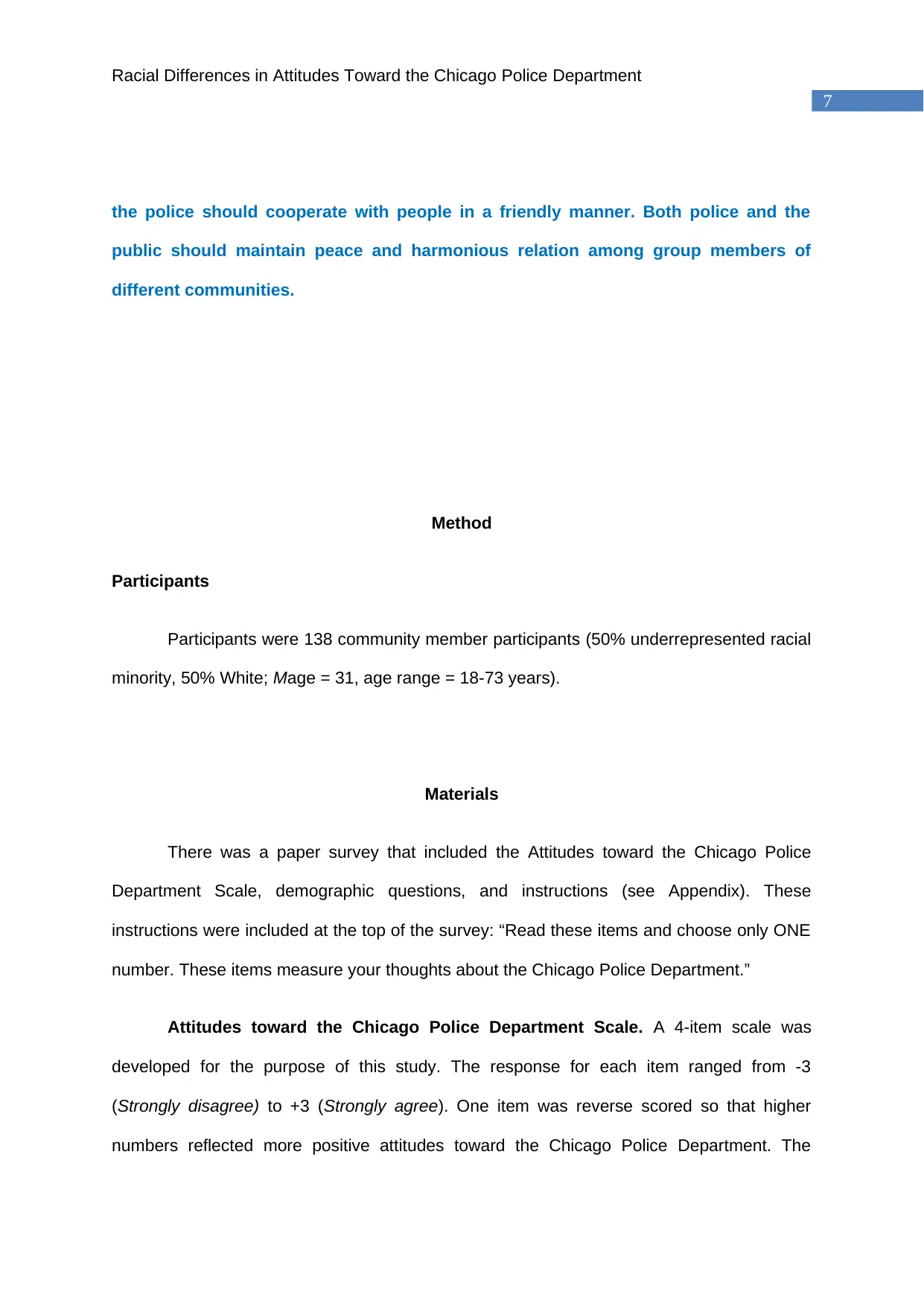
7
Racial Differences in Attitudes Toward the Chicago Police Department
the police should cooperate with people in a friendly manner. Both police and the
public should maintain peace and harmonious relation among group members of
different communities.
Method
Participants
Participants were 138 community member participants (50% underrepresented racial
minority, 50% White; Mage = 31, age range = 18-73 years).
Materials
There was a paper survey that included the Attitudes toward the Chicago Police
Department Scale, demographic questions, and instructions (see Appendix). These
instructions were included at the top of the survey: “Read these items and choose only ONE
number. These items measure your thoughts about the Chicago Police Department.”
Attitudes toward the Chicago Police Department Scale. A 4-item scale was
developed for the purpose of this study. The response for each item ranged from -3
(Strongly disagree) to +3 (Strongly agree). One item was reverse scored so that higher
numbers reflected more positive attitudes toward the Chicago Police Department. The
Racial Differences in Attitudes Toward the Chicago Police Department
the police should cooperate with people in a friendly manner. Both police and the
public should maintain peace and harmonious relation among group members of
different communities.
Method
Participants
Participants were 138 community member participants (50% underrepresented racial
minority, 50% White; Mage = 31, age range = 18-73 years).
Materials
There was a paper survey that included the Attitudes toward the Chicago Police
Department Scale, demographic questions, and instructions (see Appendix). These
instructions were included at the top of the survey: “Read these items and choose only ONE
number. These items measure your thoughts about the Chicago Police Department.”
Attitudes toward the Chicago Police Department Scale. A 4-item scale was
developed for the purpose of this study. The response for each item ranged from -3
(Strongly disagree) to +3 (Strongly agree). One item was reverse scored so that higher
numbers reflected more positive attitudes toward the Chicago Police Department. The
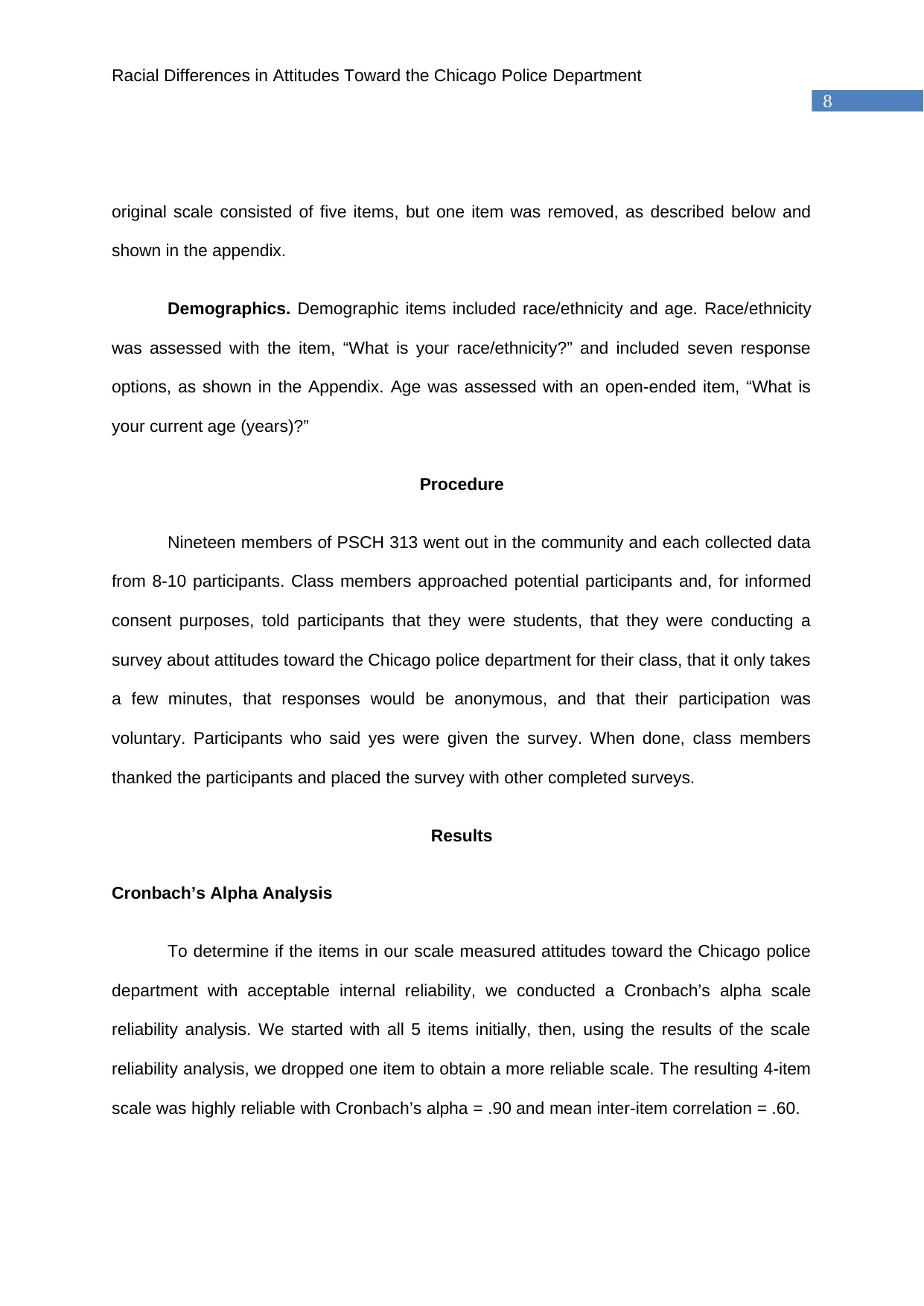
8
Racial Differences in Attitudes Toward the Chicago Police Department
original scale consisted of five items, but one item was removed, as described below and
shown in the appendix.
Demographics. Demographic items included race/ethnicity and age. Race/ethnicity
was assessed with the item, “What is your race/ethnicity?” and included seven response
options, as shown in the Appendix. Age was assessed with an open-ended item, “What is
your current age (years)?”
Procedure
Nineteen members of PSCH 313 went out in the community and each collected data
from 8-10 participants. Class members approached potential participants and, for informed
consent purposes, told participants that they were students, that they were conducting a
survey about attitudes toward the Chicago police department for their class, that it only takes
a few minutes, that responses would be anonymous, and that their participation was
voluntary. Participants who said yes were given the survey. When done, class members
thanked the participants and placed the survey with other completed surveys.
Results
Cronbach’s Alpha Analysis
To determine if the items in our scale measured attitudes toward the Chicago police
department with acceptable internal reliability, we conducted a Cronbach’s alpha scale
reliability analysis. We started with all 5 items initially, then, using the results of the scale
reliability analysis, we dropped one item to obtain a more reliable scale. The resulting 4-item
scale was highly reliable with Cronbach’s alpha = .90 and mean inter-item correlation = .60.
Racial Differences in Attitudes Toward the Chicago Police Department
original scale consisted of five items, but one item was removed, as described below and
shown in the appendix.
Demographics. Demographic items included race/ethnicity and age. Race/ethnicity
was assessed with the item, “What is your race/ethnicity?” and included seven response
options, as shown in the Appendix. Age was assessed with an open-ended item, “What is
your current age (years)?”
Procedure
Nineteen members of PSCH 313 went out in the community and each collected data
from 8-10 participants. Class members approached potential participants and, for informed
consent purposes, told participants that they were students, that they were conducting a
survey about attitudes toward the Chicago police department for their class, that it only takes
a few minutes, that responses would be anonymous, and that their participation was
voluntary. Participants who said yes were given the survey. When done, class members
thanked the participants and placed the survey with other completed surveys.
Results
Cronbach’s Alpha Analysis
To determine if the items in our scale measured attitudes toward the Chicago police
department with acceptable internal reliability, we conducted a Cronbach’s alpha scale
reliability analysis. We started with all 5 items initially, then, using the results of the scale
reliability analysis, we dropped one item to obtain a more reliable scale. The resulting 4-item
scale was highly reliable with Cronbach’s alpha = .90 and mean inter-item correlation = .60.
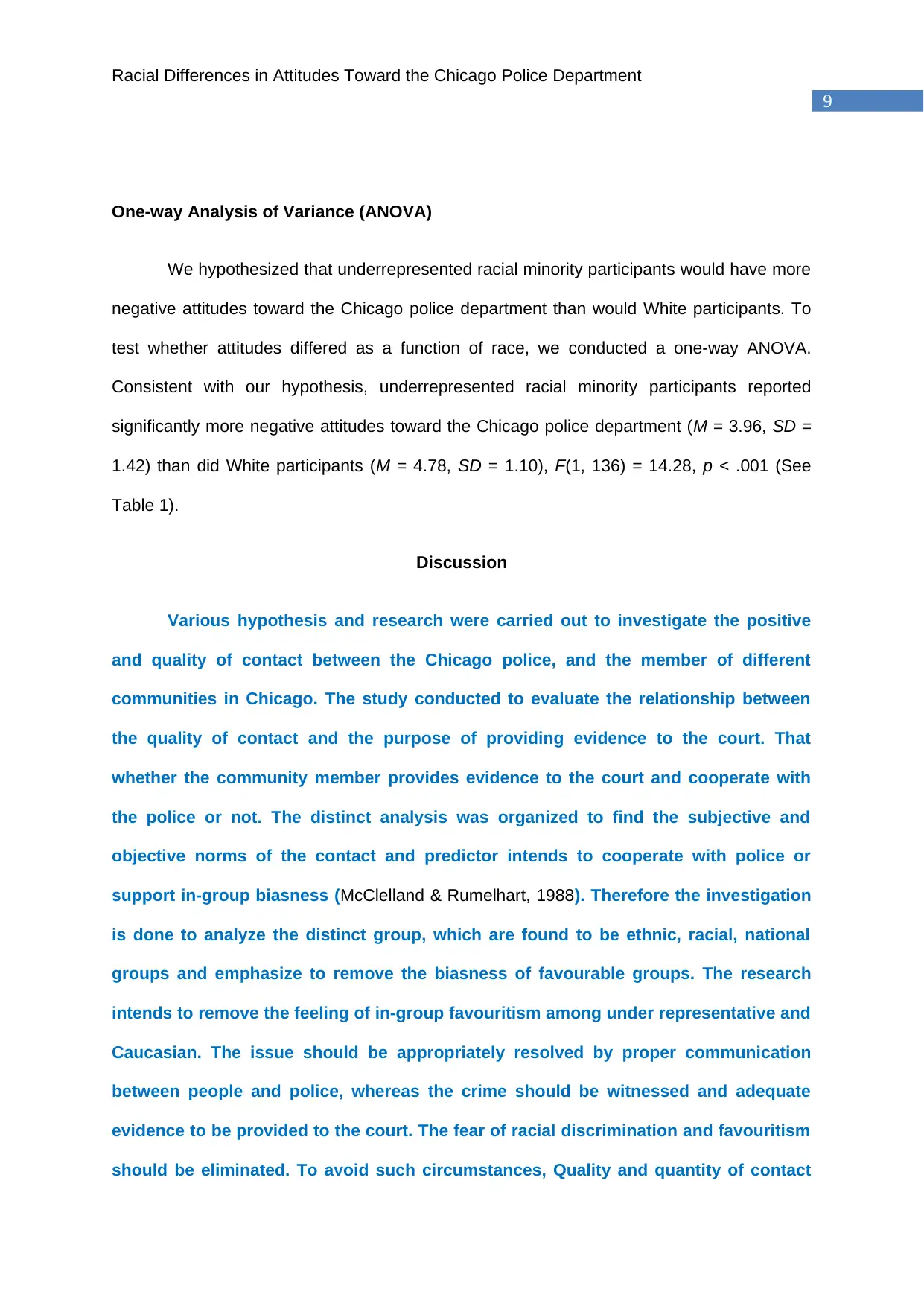
9
Racial Differences in Attitudes Toward the Chicago Police Department
One-way Analysis of Variance (ANOVA)
We hypothesized that underrepresented racial minority participants would have more
negative attitudes toward the Chicago police department than would White participants. To
test whether attitudes differed as a function of race, we conducted a one-way ANOVA.
Consistent with our hypothesis, underrepresented racial minority participants reported
significantly more negative attitudes toward the Chicago police department (M = 3.96, SD =
1.42) than did White participants (M = 4.78, SD = 1.10), F(1, 136) = 14.28, p < .001 (See
Table 1).
Discussion
Various hypothesis and research were carried out to investigate the positive
and quality of contact between the Chicago police, and the member of different
communities in Chicago. The study conducted to evaluate the relationship between
the quality of contact and the purpose of providing evidence to the court. That
whether the community member provides evidence to the court and cooperate with
the police or not. The distinct analysis was organized to find the subjective and
objective norms of the contact and predictor intends to cooperate with police or
support in-group biasness (McClelland & Rumelhart, 1988). Therefore the investigation
is done to analyze the distinct group, which are found to be ethnic, racial, national
groups and emphasize to remove the biasness of favourable groups. The research
intends to remove the feeling of in-group favouritism among under representative and
Caucasian. The issue should be appropriately resolved by proper communication
between people and police, whereas the crime should be witnessed and adequate
evidence to be provided to the court. The fear of racial discrimination and favouritism
should be eliminated. To avoid such circumstances, Quality and quantity of contact
Racial Differences in Attitudes Toward the Chicago Police Department
One-way Analysis of Variance (ANOVA)
We hypothesized that underrepresented racial minority participants would have more
negative attitudes toward the Chicago police department than would White participants. To
test whether attitudes differed as a function of race, we conducted a one-way ANOVA.
Consistent with our hypothesis, underrepresented racial minority participants reported
significantly more negative attitudes toward the Chicago police department (M = 3.96, SD =
1.42) than did White participants (M = 4.78, SD = 1.10), F(1, 136) = 14.28, p < .001 (See
Table 1).
Discussion
Various hypothesis and research were carried out to investigate the positive
and quality of contact between the Chicago police, and the member of different
communities in Chicago. The study conducted to evaluate the relationship between
the quality of contact and the purpose of providing evidence to the court. That
whether the community member provides evidence to the court and cooperate with
the police or not. The distinct analysis was organized to find the subjective and
objective norms of the contact and predictor intends to cooperate with police or
support in-group biasness (McClelland & Rumelhart, 1988). Therefore the investigation
is done to analyze the distinct group, which are found to be ethnic, racial, national
groups and emphasize to remove the biasness of favourable groups. The research
intends to remove the feeling of in-group favouritism among under representative and
Caucasian. The issue should be appropriately resolved by proper communication
between people and police, whereas the crime should be witnessed and adequate
evidence to be provided to the court. The fear of racial discrimination and favouritism
should be eliminated. To avoid such circumstances, Quality and quantity of contact
Secure Best Marks with AI Grader
Need help grading? Try our AI Grader for instant feedback on your assignments.
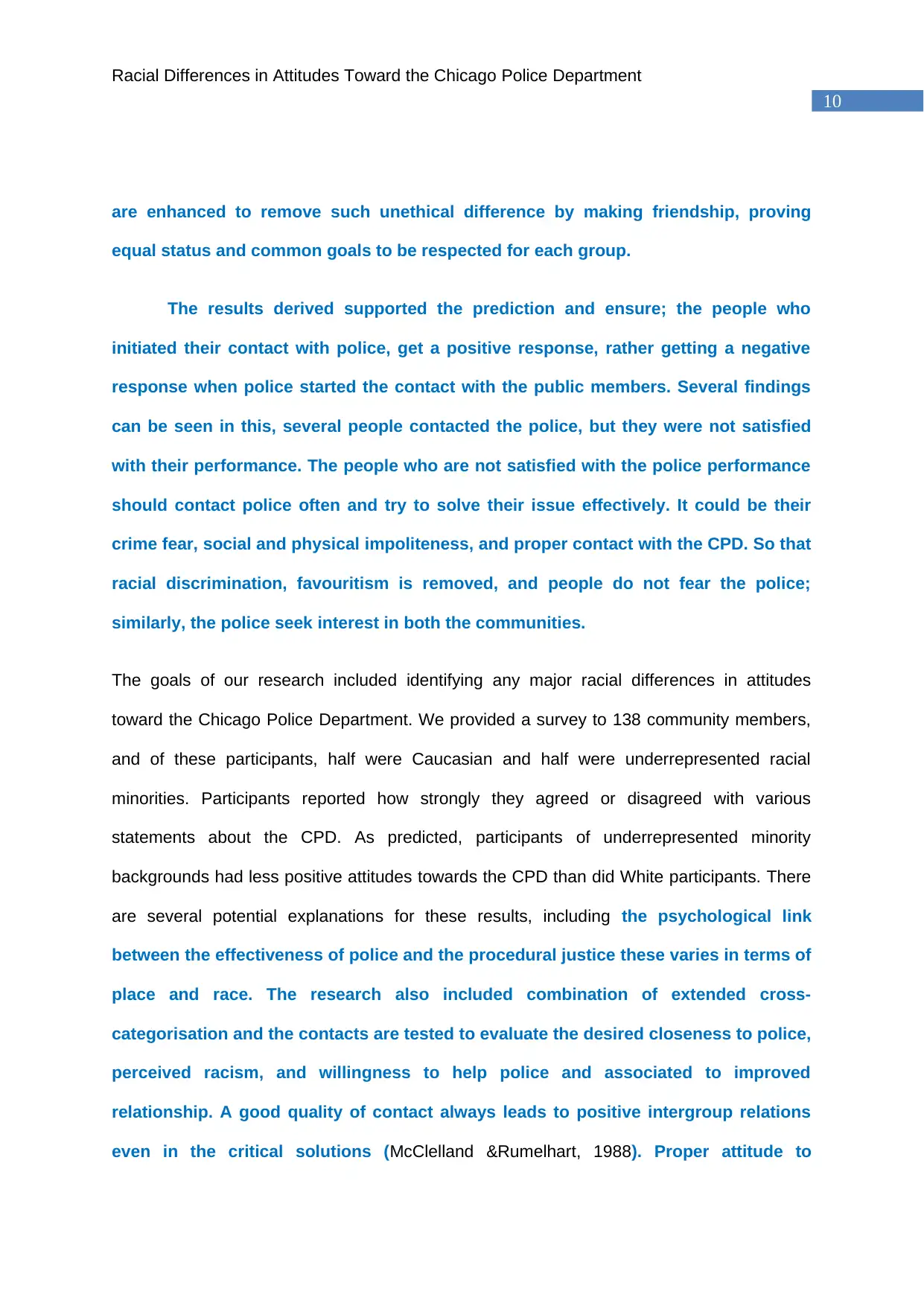
10
Racial Differences in Attitudes Toward the Chicago Police Department
are enhanced to remove such unethical difference by making friendship, proving
equal status and common goals to be respected for each group.
The results derived supported the prediction and ensure; the people who
initiated their contact with police, get a positive response, rather getting a negative
response when police started the contact with the public members. Several findings
can be seen in this, several people contacted the police, but they were not satisfied
with their performance. The people who are not satisfied with the police performance
should contact police often and try to solve their issue effectively. It could be their
crime fear, social and physical impoliteness, and proper contact with the CPD. So that
racial discrimination, favouritism is removed, and people do not fear the police;
similarly, the police seek interest in both the communities.
The goals of our research included identifying any major racial differences in attitudes
toward the Chicago Police Department. We provided a survey to 138 community members,
and of these participants, half were Caucasian and half were underrepresented racial
minorities. Participants reported how strongly they agreed or disagreed with various
statements about the CPD. As predicted, participants of underrepresented minority
backgrounds had less positive attitudes towards the CPD than did White participants. There
are several potential explanations for these results, including the psychological link
between the effectiveness of police and the procedural justice these varies in terms of
place and race. The research also included combination of extended cross-
categorisation and the contacts are tested to evaluate the desired closeness to police,
perceived racism, and willingness to help police and associated to improved
relationship. A good quality of contact always leads to positive intergroup relations
even in the critical solutions (McClelland &Rumelhart, 1988). Proper attitude to
Racial Differences in Attitudes Toward the Chicago Police Department
are enhanced to remove such unethical difference by making friendship, proving
equal status and common goals to be respected for each group.
The results derived supported the prediction and ensure; the people who
initiated their contact with police, get a positive response, rather getting a negative
response when police started the contact with the public members. Several findings
can be seen in this, several people contacted the police, but they were not satisfied
with their performance. The people who are not satisfied with the police performance
should contact police often and try to solve their issue effectively. It could be their
crime fear, social and physical impoliteness, and proper contact with the CPD. So that
racial discrimination, favouritism is removed, and people do not fear the police;
similarly, the police seek interest in both the communities.
The goals of our research included identifying any major racial differences in attitudes
toward the Chicago Police Department. We provided a survey to 138 community members,
and of these participants, half were Caucasian and half were underrepresented racial
minorities. Participants reported how strongly they agreed or disagreed with various
statements about the CPD. As predicted, participants of underrepresented minority
backgrounds had less positive attitudes towards the CPD than did White participants. There
are several potential explanations for these results, including the psychological link
between the effectiveness of police and the procedural justice these varies in terms of
place and race. The research also included combination of extended cross-
categorisation and the contacts are tested to evaluate the desired closeness to police,
perceived racism, and willingness to help police and associated to improved
relationship. A good quality of contact always leads to positive intergroup relations
even in the critical solutions (McClelland &Rumelhart, 1988). Proper attitude to
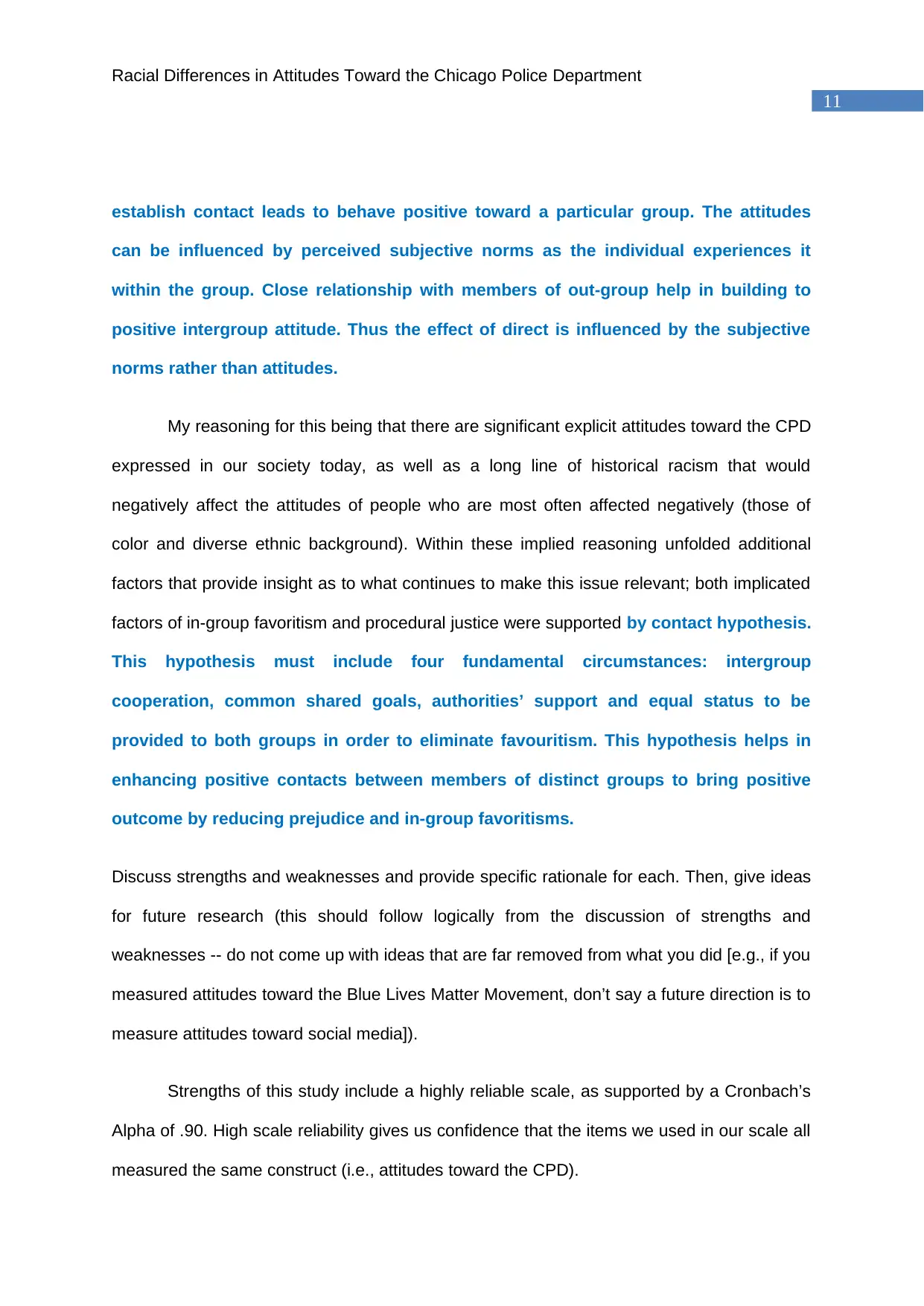
11
Racial Differences in Attitudes Toward the Chicago Police Department
establish contact leads to behave positive toward a particular group. The attitudes
can be influenced by perceived subjective norms as the individual experiences it
within the group. Close relationship with members of out-group help in building to
positive intergroup attitude. Thus the effect of direct is influenced by the subjective
norms rather than attitudes.
My reasoning for this being that there are significant explicit attitudes toward the CPD
expressed in our society today, as well as a long line of historical racism that would
negatively affect the attitudes of people who are most often affected negatively (those of
color and diverse ethnic background). Within these implied reasoning unfolded additional
factors that provide insight as to what continues to make this issue relevant; both implicated
factors of in-group favoritism and procedural justice were supported by contact hypothesis.
This hypothesis must include four fundamental circumstances: intergroup
cooperation, common shared goals, authorities’ support and equal status to be
provided to both groups in order to eliminate favouritism. This hypothesis helps in
enhancing positive contacts between members of distinct groups to bring positive
outcome by reducing prejudice and in-group favoritisms.
Discuss strengths and weaknesses and provide specific rationale for each. Then, give ideas
for future research (this should follow logically from the discussion of strengths and
weaknesses -- do not come up with ideas that are far removed from what you did [e.g., if you
measured attitudes toward the Blue Lives Matter Movement, don’t say a future direction is to
measure attitudes toward social media]).
Strengths of this study include a highly reliable scale, as supported by a Cronbach’s
Alpha of .90. High scale reliability gives us confidence that the items we used in our scale all
measured the same construct (i.e., attitudes toward the CPD).
Racial Differences in Attitudes Toward the Chicago Police Department
establish contact leads to behave positive toward a particular group. The attitudes
can be influenced by perceived subjective norms as the individual experiences it
within the group. Close relationship with members of out-group help in building to
positive intergroup attitude. Thus the effect of direct is influenced by the subjective
norms rather than attitudes.
My reasoning for this being that there are significant explicit attitudes toward the CPD
expressed in our society today, as well as a long line of historical racism that would
negatively affect the attitudes of people who are most often affected negatively (those of
color and diverse ethnic background). Within these implied reasoning unfolded additional
factors that provide insight as to what continues to make this issue relevant; both implicated
factors of in-group favoritism and procedural justice were supported by contact hypothesis.
This hypothesis must include four fundamental circumstances: intergroup
cooperation, common shared goals, authorities’ support and equal status to be
provided to both groups in order to eliminate favouritism. This hypothesis helps in
enhancing positive contacts between members of distinct groups to bring positive
outcome by reducing prejudice and in-group favoritisms.
Discuss strengths and weaknesses and provide specific rationale for each. Then, give ideas
for future research (this should follow logically from the discussion of strengths and
weaknesses -- do not come up with ideas that are far removed from what you did [e.g., if you
measured attitudes toward the Blue Lives Matter Movement, don’t say a future direction is to
measure attitudes toward social media]).
Strengths of this study include a highly reliable scale, as supported by a Cronbach’s
Alpha of .90. High scale reliability gives us confidence that the items we used in our scale all
measured the same construct (i.e., attitudes toward the CPD).
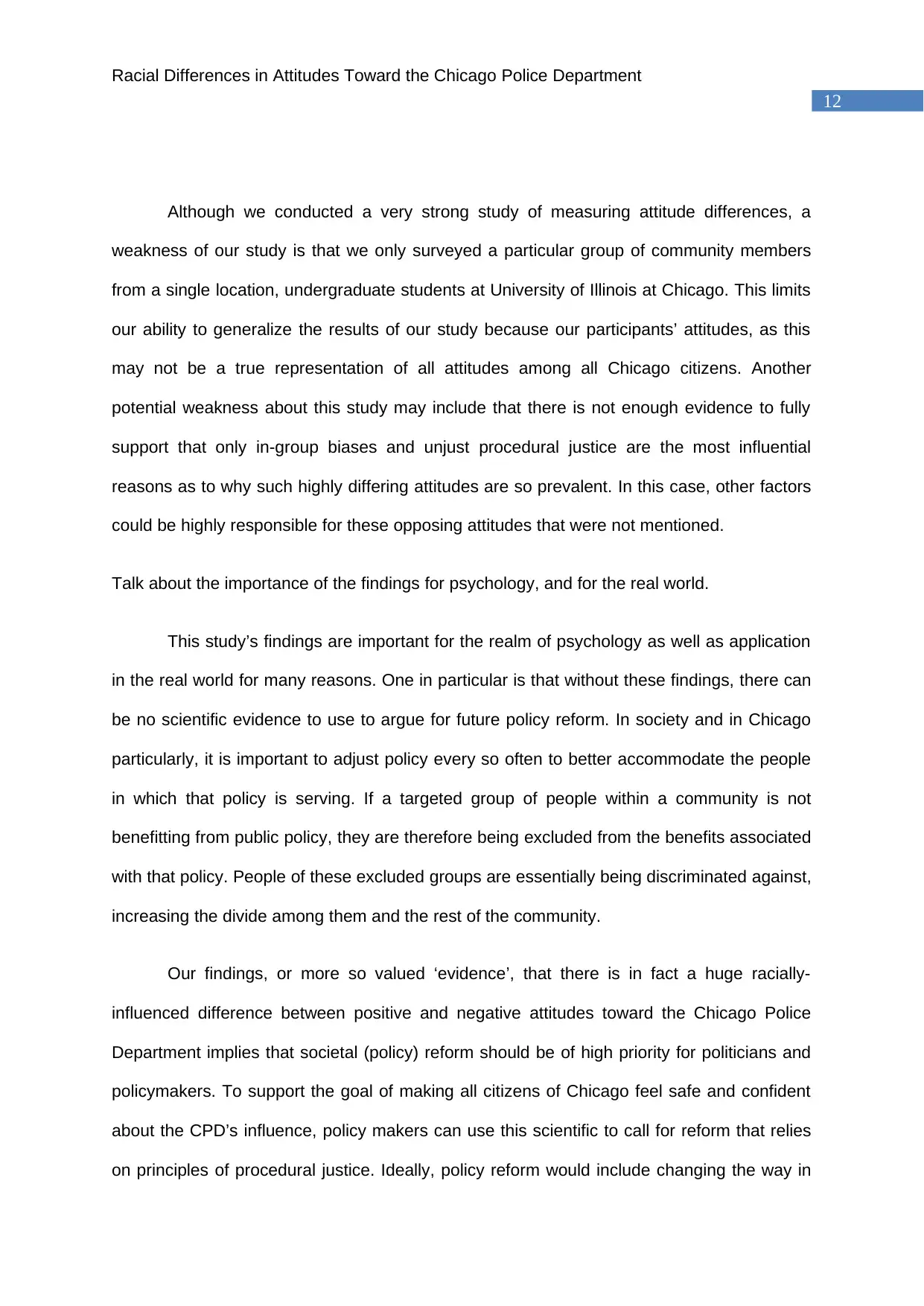
12
Racial Differences in Attitudes Toward the Chicago Police Department
Although we conducted a very strong study of measuring attitude differences, a
weakness of our study is that we only surveyed a particular group of community members
from a single location, undergraduate students at University of Illinois at Chicago. This limits
our ability to generalize the results of our study because our participants’ attitudes, as this
may not be a true representation of all attitudes among all Chicago citizens. Another
potential weakness about this study may include that there is not enough evidence to fully
support that only in-group biases and unjust procedural justice are the most influential
reasons as to why such highly differing attitudes are so prevalent. In this case, other factors
could be highly responsible for these opposing attitudes that were not mentioned.
Talk about the importance of the findings for psychology, and for the real world.
This study’s findings are important for the realm of psychology as well as application
in the real world for many reasons. One in particular is that without these findings, there can
be no scientific evidence to use to argue for future policy reform. In society and in Chicago
particularly, it is important to adjust policy every so often to better accommodate the people
in which that policy is serving. If a targeted group of people within a community is not
benefitting from public policy, they are therefore being excluded from the benefits associated
with that policy. People of these excluded groups are essentially being discriminated against,
increasing the divide among them and the rest of the community.
Our findings, or more so valued ‘evidence’, that there is in fact a huge racially-
influenced difference between positive and negative attitudes toward the Chicago Police
Department implies that societal (policy) reform should be of high priority for politicians and
policymakers. To support the goal of making all citizens of Chicago feel safe and confident
about the CPD’s influence, policy makers can use this scientific to call for reform that relies
on principles of procedural justice. Ideally, policy reform would include changing the way in
Racial Differences in Attitudes Toward the Chicago Police Department
Although we conducted a very strong study of measuring attitude differences, a
weakness of our study is that we only surveyed a particular group of community members
from a single location, undergraduate students at University of Illinois at Chicago. This limits
our ability to generalize the results of our study because our participants’ attitudes, as this
may not be a true representation of all attitudes among all Chicago citizens. Another
potential weakness about this study may include that there is not enough evidence to fully
support that only in-group biases and unjust procedural justice are the most influential
reasons as to why such highly differing attitudes are so prevalent. In this case, other factors
could be highly responsible for these opposing attitudes that were not mentioned.
Talk about the importance of the findings for psychology, and for the real world.
This study’s findings are important for the realm of psychology as well as application
in the real world for many reasons. One in particular is that without these findings, there can
be no scientific evidence to use to argue for future policy reform. In society and in Chicago
particularly, it is important to adjust policy every so often to better accommodate the people
in which that policy is serving. If a targeted group of people within a community is not
benefitting from public policy, they are therefore being excluded from the benefits associated
with that policy. People of these excluded groups are essentially being discriminated against,
increasing the divide among them and the rest of the community.
Our findings, or more so valued ‘evidence’, that there is in fact a huge racially-
influenced difference between positive and negative attitudes toward the Chicago Police
Department implies that societal (policy) reform should be of high priority for politicians and
policymakers. To support the goal of making all citizens of Chicago feel safe and confident
about the CPD’s influence, policy makers can use this scientific to call for reform that relies
on principles of procedural justice. Ideally, policy reform would include changing the way in
Paraphrase This Document
Need a fresh take? Get an instant paraphrase of this document with our AI Paraphraser
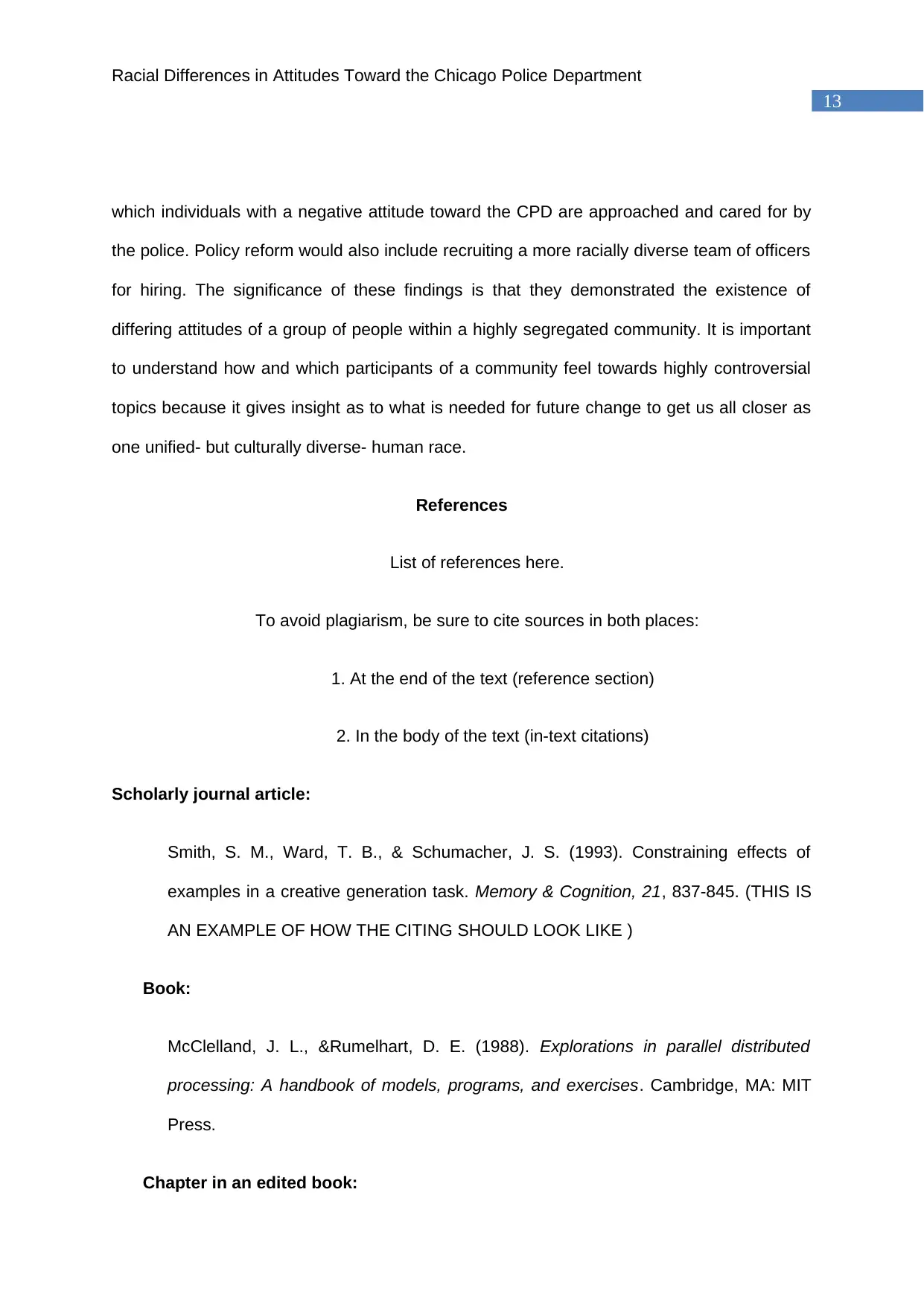
13
Racial Differences in Attitudes Toward the Chicago Police Department
which individuals with a negative attitude toward the CPD are approached and cared for by
the police. Policy reform would also include recruiting a more racially diverse team of officers
for hiring. The significance of these findings is that they demonstrated the existence of
differing attitudes of a group of people within a highly segregated community. It is important
to understand how and which participants of a community feel towards highly controversial
topics because it gives insight as to what is needed for future change to get us all closer as
one unified- but culturally diverse- human race.
References
List of references here.
To avoid plagiarism, be sure to cite sources in both places:
1. At the end of the text (reference section)
2. In the body of the text (in-text citations)
Scholarly journal article:
Smith, S. M., Ward, T. B., & Schumacher, J. S. (1993). Constraining effects of
examples in a creative generation task. Memory & Cognition, 21, 837-845. (THIS IS
AN EXAMPLE OF HOW THE CITING SHOULD LOOK LIKE )
Book:
McClelland, J. L., &Rumelhart, D. E. (1988). Explorations in parallel distributed
processing: A handbook of models, programs, and exercises. Cambridge, MA: MIT
Press.
Chapter in an edited book:
Racial Differences in Attitudes Toward the Chicago Police Department
which individuals with a negative attitude toward the CPD are approached and cared for by
the police. Policy reform would also include recruiting a more racially diverse team of officers
for hiring. The significance of these findings is that they demonstrated the existence of
differing attitudes of a group of people within a highly segregated community. It is important
to understand how and which participants of a community feel towards highly controversial
topics because it gives insight as to what is needed for future change to get us all closer as
one unified- but culturally diverse- human race.
References
List of references here.
To avoid plagiarism, be sure to cite sources in both places:
1. At the end of the text (reference section)
2. In the body of the text (in-text citations)
Scholarly journal article:
Smith, S. M., Ward, T. B., & Schumacher, J. S. (1993). Constraining effects of
examples in a creative generation task. Memory & Cognition, 21, 837-845. (THIS IS
AN EXAMPLE OF HOW THE CITING SHOULD LOOK LIKE )
Book:
McClelland, J. L., &Rumelhart, D. E. (1988). Explorations in parallel distributed
processing: A handbook of models, programs, and exercises. Cambridge, MA: MIT
Press.
Chapter in an edited book:
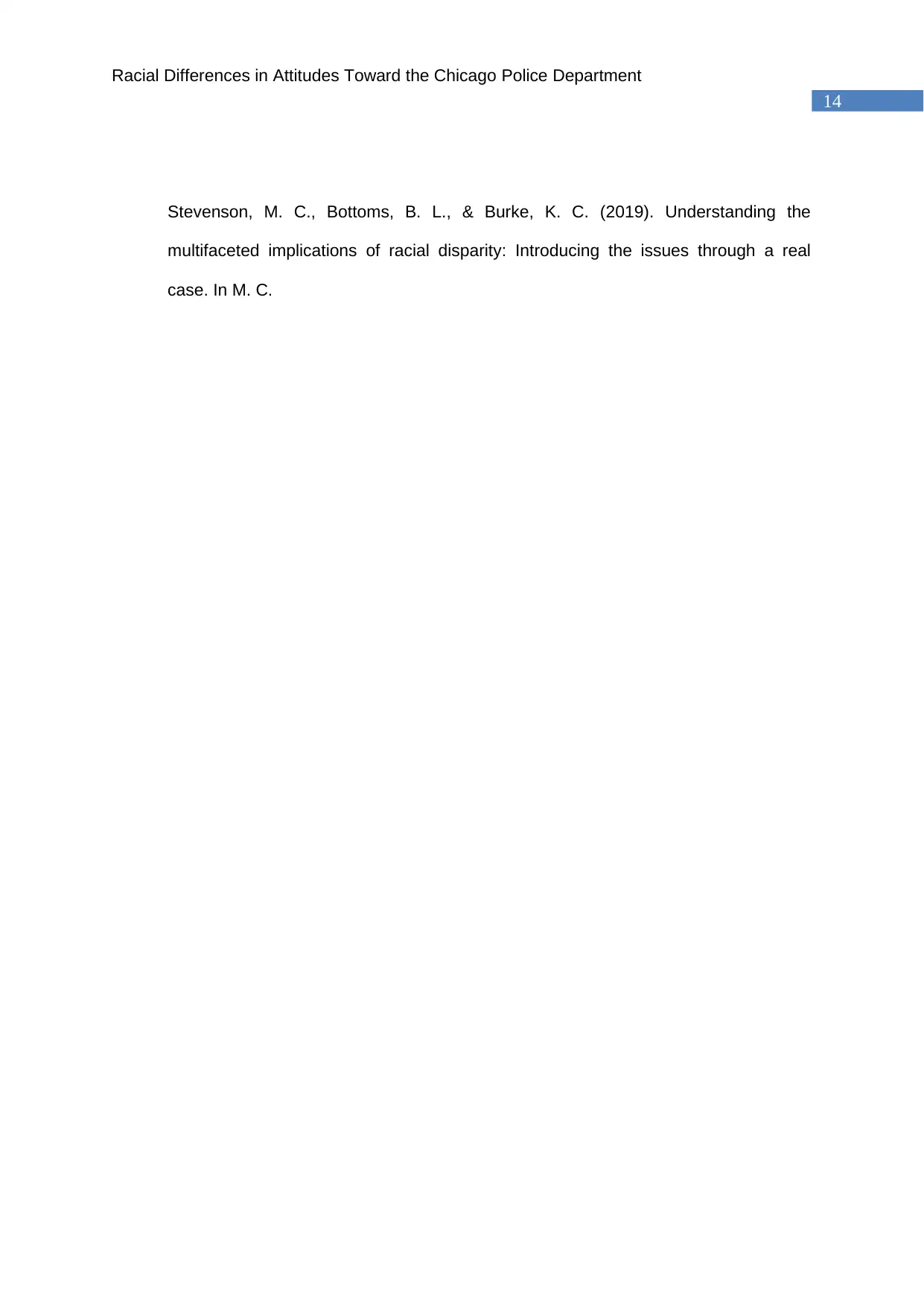
14
Racial Differences in Attitudes Toward the Chicago Police Department
Stevenson, M. C., Bottoms, B. L., & Burke, K. C. (2019). Understanding the
multifaceted implications of racial disparity: Introducing the issues through a real
case. In M. C.
Racial Differences in Attitudes Toward the Chicago Police Department
Stevenson, M. C., Bottoms, B. L., & Burke, K. C. (2019). Understanding the
multifaceted implications of racial disparity: Introducing the issues through a real
case. In M. C.
1 out of 15
Your All-in-One AI-Powered Toolkit for Academic Success.
+13062052269
info@desklib.com
Available 24*7 on WhatsApp / Email
![[object Object]](/_next/static/media/star-bottom.7253800d.svg)
Unlock your academic potential
© 2024 | Zucol Services PVT LTD | All rights reserved.